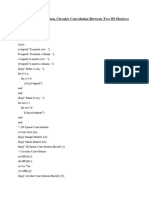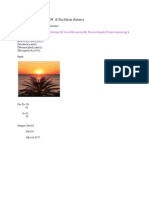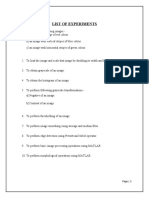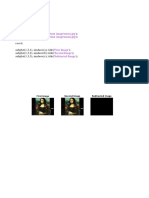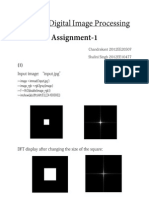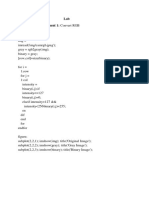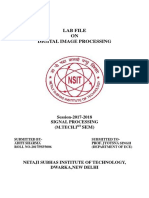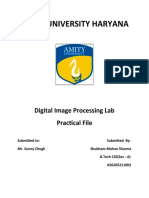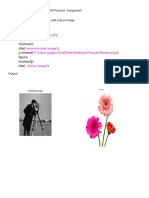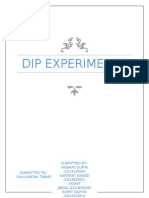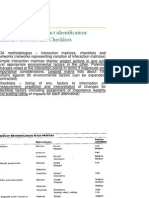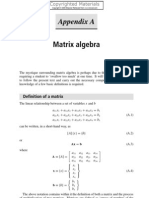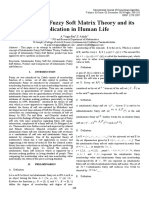1.
Perform 2D Linear Convolution, Circular Convolution between
two 2D matrices
clc;
clear;
x=input("Enter the 1st matrix for linear convolution");
h=input("Enter the 2nd matrix for linear convolution");
y=conv2(x,h);
disp(y);
x1=input("Enter the 1st matrix for circular convolution");
x2=input("Enter the 2nd matrix for circular convolution");
x1=fft(x1,-1);
x2=fft(x2,-1);
x3=x1.*x2;
z=fft(x3,1);
disp(z);
Output
�2.Perform Discrete Fourier Transform(DFT), Discrete Cosine
Transform(DCT) of 4*4 image
clc;
clear;
x=input("Enter matrix to find DFT");
l=length(x);
n=4;
x1=fft(x,-1);
disp(x1);
y=input("Enter matrix to find DCT");
y1=dct(y,-1);
disp(y1);
Output
�3.Perform Brightness Enhancement, Contrast Manipulation, Image
negative of an image.
clear;
clc;
x=imread("C:\Users\USER\Pictures\lenaimage1.jpg");
a=rgb2gray(x);
figure;
subplot(3,2,1)
imshow(x);
title('Original image');
subplot(3,2,2)
imshow(a);
title('Gray image');
b=double(a)+50;
b=uint8(b);
subplot(3,2,3)
imshow(b)
title('Brightness Enhancement');
c=double(a)*0.5;
c=uint8(c);
d=double(c)*2;
d=uint8(d);
subplot(3,2,4)
imshow(c);
title('Increase in contrast');
subplot(3,2,5)
imshow(d)
title('Decrease in contrast');
f=imcomplement(x);
subplot(3,2,6)
imshow(f);
title('Negative of an image');
�Output
�4.Perform Threshold Operation on an image
clear;
clc;
a=imread("C:\Users\USER\Pictures\lenaimage1.jpg");
a=rgb2gray(a);
[m n]=size(a);
t=input('Enter the threshold parameter');
for i=1:m
for j=1:n
if(a(i,j)<t)
b(i,j)=0;
else
b(i,j)=255;
end
end
end
imshow(b);
title('threshold image');
xlabel(sprintf('threshold value is %g',t));
�Output
�5.Perform Edge Detection using different edge detectors
clear;
clc;
a=imread("C:\Users\USER\Pictures\lenaimage1.jpg");
b=rgb2gray(a);
c=edge(b,'sobel');
d=edge(b,'prewitt');
e=edge(b,'log');
f=edge(b,'canny');
figure;
subplot(3,2,1)
imshow(a);
title('Original image');
subplot(3,2,2)
imshow(b);
title('Gray image');
subplot(3,2,3)
imshow(c)
title('Sobel');
subplot(3,2,4)
imshow(d);
title('Prewitt');
subplot(3,2,5)
imshow(e);
title('Log');
subplot(3,2,6)
imshow(f);
title('Canny');
�Output
�6.Perform Dilation and Erosion Operation
clc;
clear;
a=imread("C:\Users\USER\Pictures\morph.png");
SE=imcreatese('rect',6,6);
img=imdilate(a,SE);
img1=imerode(a,SE);
figure;
subplot(2,2,1)
imshow(a);
title('Original Image');
subplot(2,2,2)
imshow(img);
title('Dilated image');
subplot(2,2,3)
imshow(a);
title('Original Image');
subplot(2,2,4)
imshow(img1);
title('Eroded image');
�Output
�7.Perform Opening and Closing Operation
clc;
clear;
a=imread("C:\Users\USER\Pictures\sample.png");
SE=imcreatese('rect',15,15);
img=imopen(a,SE);
img1=imclose(a,SE);
figure
subplot(2,2,1)
imshow(a);
title('Original image');
subplot(2,2,2)
imshow(img);
title('Opened image');
subplot(2,2,3)
imshow(a);
title('Original image');
subplot(2,2,4)
imshow(img1);
title('Closed image');
�Output
�8.Read a Colour image and separate the image into red,blue and
green planes
clc;
clear;
a=imread("C:\Users\USER\Pictures\lenaimage1.jpg");
b=a;
subplot(2,2,1)
imshow(a);
title('Rgb image');
a(:,:,2)=0;
a(:,:,3)=0;
subplot(2,2,2)
imshow(a);
title('Red image');
a=b;
a(:,:,1)=0;
a(:,:,3)=0;
subplot(2,2,3)
imshow(a);
title('Green image');
a=b;
a(:,:,1)=0;
a(:,:,2)=0;
subplot(2,2,4)
imshow(a);
title('Blue image');
�Output
